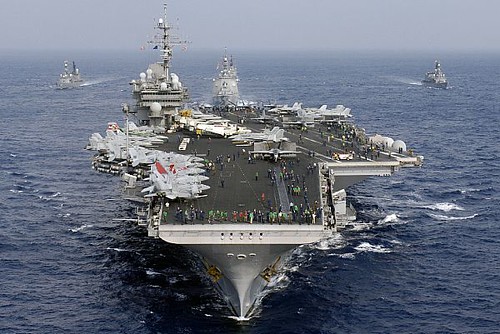Greening the Blue Water Fleet
Those targets, the Navy secretary said on day one of the two-day conference, include changing the way the Navy and Marine Corps award contracts during the acquisition process to consider the lifetime energy cost of the system;
- By 2012, creating a “Green Strike Group” composed of nuclear vessels and ships powered by biofuels and deploying that fleet by 2016;
- By 2015, reducing petroleum use in its 50,000 commercial vehicle fleet by 50 percent by phasing in hybrid fuel and electric vehicles;
- Producing at least half the shore-based energy requirements from renewable sources, such as solar, wind and ocean generated by the base; and by 2020,
- Ensuring at least 40 percent of the Navy’s total energy consumption comes from alternative sources.
“Leading change is not new for the Department of the Navy,” said Mabus. “We are a better Navy and a better Marine Corps for innovation. We have led the world in the adoption of new energy strategies in the past. This is our legacy.”

The forum, hosted by the Office of Naval Research and the Navy’s Task Force Energy, was organized to introduce the Department of Navy emerging energy strategy and initiatives, and gain insight from dialogues with participants, event organizers said. It was focused around three key themes tied to energy–security, efficiency and environmental stewardship.
In addition to Mabus, Chief of Naval Operations Adm. Gary Roughead also shared his vision of the Navy’s energy strategy with the cross-section of representatives from federal government agencies, academic institutions, small business and the defense industry.
The Department of Defense is the largest government and individual petroleum user in the United States, guzzling about 330,000 barrels of oil per day, according to military officials. The Department of the Navy is the second largest fuel user in the DoD, consuming about 100,000 barrels a day. About 75 percent of all fuel products are transported by sea, much of it passing through vulnerable points protected by U.S. naval forces, officials said.“For all of you in here, it comes as no surprise that energy powers our way of life,” Roughead said during his speech. “I also think that as we go forward, the Navy can continue to be a great steward of our environment. The initiatives that we are going to explore here, and things that we are doing with Task Force Energy and Task Force Climate Change, allow us to be able to continue that reputation of stewardship.”
Highlighting the importance of science and technology as the Navy plots its energy strategy, Roughead said, “Everything doesn’t have to be game-changing technology, even though I’ve challenged (the Office of Naval Research) to find ’the next big thing.’”
The Navy and Marine Corps’ science and technology provider, the Office of Naval Research (ONR) invests in a wide range of energy science and technology projects. Dr. Larry Schuette, ONR’s director of innovation, participated in the “Pitch a Principal” program where interested parties discussed funding opportunities with ONR. He said the forum was a great platform to exchange ideas.
“This was the perfect opportunity for industry and our warfighter partners to meet a broad range of subject matter experts one-on-one,” Schuette said.
You can return to the main Market News page, or press the Back button on your browser.

